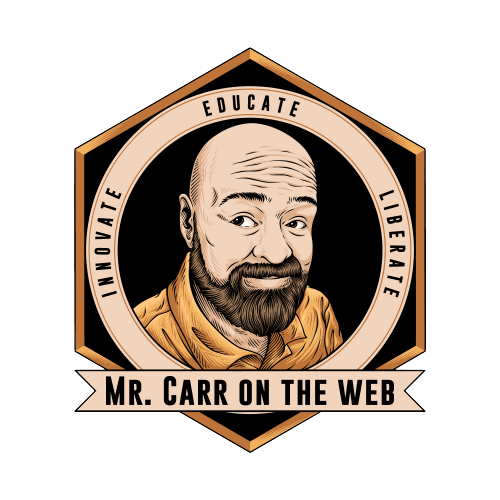Build & Tell, and Code: Enhancing Computational Thinking with Sphero Indi and EduProtocols
As educators, we’re always on the lookout for tools and strategies that not only engage our students but also help them develop essential skills for the future. Enter Sphero Indi, a small but mighty robot that brings coding to life, and the Build & Tell EduProtocol (a adaptation of the Sketch & Tell) —an approach that combines creativity with critical thinking in a way that’s as fun as it is educational. Inspired by Ariana Hernandez’s brilliant idea, this post will show you how to use these tools to unlock the full potential of your students’ computational thinking skills.
Check out Indi in action in this video
What is Sphero Indi and the Build & Tell EduProtocol?
Let’s start with the basics. Sphero Indi is a simple, intuitive robot designed to introduce young learners to the world of coding (but don’t let those surly high schoolers fool you, they love Indi, too). Instead of complex code, students use colored tiles to create a path for Indi to follow. Each color tells Indi to do something different—green means go, red means stop, and so on. It’s coding stripped down to its core, making it accessible and engaging for even the youngest students.
Now, here’s where it gets really interesting. The Build & Tell EduProtocol takes the concept of coding with Indi and turns it into a hands-on, reflective learning experience. Instead of drawing or sketching, students build their own track using the colored tiles. They then take a photo of their creation and add it to a digital slide as part of their presentation. The "tell" part comes in when they explain the thought process behind their design, the challenges they faced, and how they overcame them. This isn’t just about getting Indi from point A to point B—it’s about understanding the why and how of the process.
Implementing Build & Tell with Sphero Indi in Groups
So, how does this look in a classroom where students work in groups? Here’s a step-by-step guide to get you started:
Forming Groups and Planning the Track: Students are divided into groups, and each group begins by planning their track together. They discuss how they want Indi to move—turn left, go straight, make a U-turn—and which color tiles they’ll need to achieve this. Don’t tell them what the tiles do…let them figure that out by putting Indi on top of them one at a time.
Building the Track Together: The group collaborates to lay down the color tiles, constructing a track that reflects their collective ideas. This step is all about creativity, communication, and spatial reasoning, as students visualize the path Indi will take.
Testing and Refining as a Group: Once the track is built, the group tests it by running Indi along the path. If it doesn’t work as expected (which usually happens), they troubleshoot as a team—adjusting the sequence of tiles, changing the layout, and testing again until they get it right.
Documenting the Process: After refining their track, the group takes a photo of their final design and adds it to a shared digital slide. This visual documentation is key to the Build & Tell process. You could alternatively have them draw the course.
Writing the Group Reflection: Before presenting, the group collectively writes a reflection on their experience. They explain the reasoning behind their track design, the challenges they encountered, and how they resolved them. This reflective writing practice helps deepen their understanding of the concepts at play.
Presenting as a Group: Finally, the group presents their slide and reflection to the class, allowing for both collaborative and individual learning through written and verbal communication. Each member of the group has a role in the presentation, ensuring that everyone contributes to the discussion.
Linking to Algorithmic and Computational Thinking
What makes this activity so powerful isn’t just the engagement factor (though that’s a big part of it). It’s how seamlessly it integrates key concepts of algorithmic and computational thinking, all within a collaborative framework.
Algorithmic Thinking: As students plan their track, they’re essentially writing an algorithm—a step-by-step set of instructions for Indi to follow. Working in groups, they learn to think like programmers, breaking down the problem (how to get Indi from start to finish) into manageable steps and discussing these as a team.
Computational Thinking: The iterative process of building, testing, and refining their track mirrors the essential elements of computational thinking—decomposition, pattern recognition, abstraction, and algorithm design. Each step in this process reinforces these skills, making them second nature to students. The group dynamic adds an extra layer of complexity, as students must communicate and negotiate their ideas effectively.
Real-World Application: These aren’t just abstract concepts. The ability to think algorithmically and computationally is crucial in today’s world, from solving everyday problems to navigating the complexities of modern technology. By engaging in activities like Build & Tell in groups, students develop a mindset that prepares them for future challenges, whether in the classroom or beyond.
Conclusion
The combination of Sphero Indi and the Build & Tell EduProtocol offers a powerful, hands-on approach to teaching coding and computational thinking in a collaborative setting. It’s not just about learning to code; it’s about understanding the process, reflecting on the experience, and applying that knowledge to new challenges.
I encourage you to try this group-based activity in your classroom. Watch as your students not only learn to code but also develop critical teamwork and problem-solving skills. And as always, I’d love to hear how it goes—drop a comment or share your experience with Build & Tell. Together, we can unlock the full potential of our students and prepare them for a world where computational thinking is key.
Want to know more about EduProtocols? Check here for upcoming webinars!
Special thanks to Ariana Hernandez for the inspiration behind Build & Tell.
